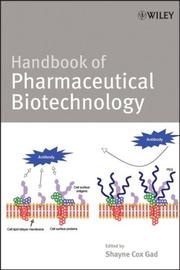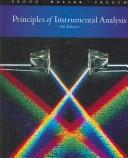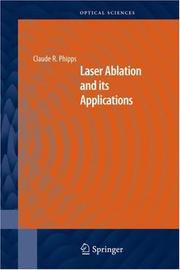| Listing 1 - 3 of 3 |
Sort by
|

ISBN: 9780471213864 0471213861 Year: 2007 Publisher: Hoboken, N.J. Wiley
Abstract | Keywords | Export | Availability | Bookmark
 Loading...
Loading...Choose an application
- Reference Manager
- EndNote
- RefWorks (Direct export to RefWorks)
biotechnologie --- Analysis of pharmaceuticals --- Biotechnology --- pharmacology --- farmacotechnologie --- farmacologie --- farmacie --- Pharmacology. Therapy --- Pharmaceutical biotechnology --- Drug Design --- Chemistry, Pharmaceutical --- bio-informatica --- stamcellen --- moleculaire biologie --- chromatografie --- genotype --- fenotypen --- proteomics --- oligonucleotides --- microarrays --- aminozuren --- biogeneesmiddelen --- enzymen --- LC (liquid chromatography) --- HPLC (high power liquid chromatography) --- Pharmaceutical biotechnology - Handbooks, manuals, etc.

ISBN: 9780495125709 9780495012016 0495012017 0495125709 Year: 2007 Publisher: Belmont, Calif. Thomson Brooks/Cole
Abstract | Keywords | Export | Availability | Bookmark
 Loading...
Loading...Choose an application
- Reference Manager
- EndNote
- RefWorks (Direct export to RefWorks)
PRINCIPLES OF INSTRUMENTAL ANALYSIS has long been the standard for courses that deal with the principles and applications of modern analytical instruments. Now with their new Sixth Edition, authors Douglas A. Skoog, F. James Holler, and Stanley R. Crouch infuse their popular text with updated techniques as well as new Instrumental Analysis in Action case studies. The book's updated material enhances its proven approach, which places an emphasis on the theoretical basis of each type of instrument, its optimal area of application, its sensitivity, its precision, and its limitations. PRINCIPLES OF INSTRUMENTAL ANALYSIS also introduces students to elementary analog and digital electronics, computers, and treatment of analytical data. A book companion website is available, providing students with tutorials on instrumental methods, Excel files of data analysis and simulations of analytical techniques to help them visualize important concepts in this course, and selected papers from the chemical literature to stimulate interest and provide background information for study. * Six new Instrumental Analysis in Action features have been added to help students see the relevance of analytical chemistry. A Challenge Problem at the end of each chapter encourages students to read the literature of analytical chemistry and to apply principles and methods. * Many chapters contain spreadsheet examples with references to the APPLICATIONS OF MICROSOFTr EXCEL IN ANALYTICAL CHEMISTRY (written by Crouch and Holler), and include corresponding end-of chapter spreadsheet problems.
optische instrumenten --- Electrochemical analysis --- GC (gaschromatografie) --- HPLC (high power liquid chromatography) --- microscopy --- Nuclear physics --- atoomkernen --- electrochromatography --- Fysicochemical separation methods --- coulometrie --- automatisering --- radiochemie --- ECM (electrochemical machining) --- potentiometrie --- analytische chemie --- Physicochemistry --- moleculen --- chromatografie --- NMR spectrometrie --- chemoluminescentie --- Electrochemistry --- fysicochemie --- elektrochemie --- spectroscopie --- fluorescentie --- spectrometrie --- IR spectroscopie --- fosforescentie --- Analytical chemistry --- infrared spectroscopy --- thermische analyse --- Raman spectroscopy --- P (fosfor) --- Instrumental analysis --- Analyse instrumentale --- Textbooks --- Manuels d'enseignement supérieur --- Analytische chemie --- Chemistry Techniques, Analytical --- 543.08 --- meettechnieken --- scheidingstechnieken --- Chemistry, Analytic --- Chemistry, Physical and theoretical --- instrumentation. --- Analytical measurement --- 543.08 Analytical measurement --- Manuels d'enseignement supérieur --- instrumentation --- versterkers --- electrophoresis --- LC (liquid chromatography) --- GC (gas chromatography) --- Textbooks. --- Instrumental analysis - Textbooks

ISBN: 9780387304526 0387304525 0387304533 Year: 2007 Publisher: New York, New York : Springer,
Abstract | Keywords | Export | Availability | Bookmark
 Loading...
Loading...Choose an application
- Reference Manager
- EndNote
- RefWorks (Direct export to RefWorks)
Laser ablation describes the interaction of intense optical fields with matter, in which atoms are selectively driven off by thermal or nonthermal mechanisms. The field of laser ablation physics is advancing so rapidly that its principal results are seen only in specialized journals and conferences. This is the first book that combines the most recent results in this rapidly advancing field with authoritative treatment of laser ablation and its applications, including the physics of high-power laser-matter interaction. Many practical applications exist, ranging from inertial confinement fusion to propulsion of aerostats for pollution monitoring to laser ignition of hypersonic engines to laser cleaning nanoscale contaminants in high-volume computer hard drive manufacture to direct observation of the electronic or dissociative states in atoms and molecules, to studying the properties of materials during 200kbar shocks developed in 200fs. Selecting topics which are representative of such a broad field is difficult. Laser Ablation and its Applications emphasizes the wide range of these topics rather than - as is so often the case in advanced science – focusing on one specialty or discipline. The book is divided into four sections: theory and modeling, ultrafast interactions, material processing and laser-matter interaction in novel regimes. The latter range from MALDI to ICF, SNOM’s and femtosecond nanosurgery to laser space propulsion. The book arose from the SPIE series of High Power Laser Ablation Symposia which began in 1998. It is intended for a graduate course in laser interactions with plasmas and materials, but it should be accessible to anyone with a graduate degree in physics or engineering. It is also intended as a major reference work to familiarize scientists just entering the field with laser ablation and its applications.
Laser ablation --- High power lasers --- Ablation laser (Fabrication) --- Lasers de puissance --- Applied Physics --- Engineering & Applied Sciences --- Physics. --- Atoms. --- Matter. --- Plasma (Ionized gases). --- Condensed matter. --- Lasers. --- Photonics. --- Electronics. --- Microelectronics. --- Materials --- Thin films. --- Laser Technology, Photonics. --- Condensed Matter Physics. --- Surfaces and Interfaces, Thin Films. --- Electronics and Microelectronics, Instrumentation. --- Atoms and Molecules in Strong Fields, Laser Matter Interaction. --- Plasma Physics. --- Surfaces. --- Surfaces (Physics). --- Optics, Lasers, Photonics, Optical Devices. --- Electrical engineering --- Physical sciences --- Physics --- Surface chemistry --- Surfaces (Technology) --- Materials—Surfaces. --- Gaseous discharge --- Gaseous plasma --- Magnetoplasma --- Ionized gases --- Condensed materials --- Condensed media --- Condensed phase --- Materials, Condensed --- Media, Condensed --- Phase, Condensed --- Liquids --- Matter --- Solids --- New optics --- Optics --- Light amplification by stimulated emission of radiation --- Masers, Optical --- Optical masers --- Light amplifiers --- Light sources --- Optoelectronic devices --- Nonlinear optics --- Optical parametric oscillators --- Natural philosophy --- Philosophy, Natural --- Dynamics --- Chemistry, Physical and theoretical --- Stereochemistry --- Microminiature electronic equipment --- Microminiaturization (Electronics) --- Electronics --- Microtechnology --- Semiconductors --- Miniature electronic equipment --- Films, Thin --- Solid film --- Solid state electronics --- Coatings --- Thick films --- Constitution --- Laser ablation. --- High power lasers. --- Lasers --- Ablation, Laser --- Laser-induced ablation --- Manufacturing processes --- Industrial applications
| Listing 1 - 3 of 3 |
Sort by
|

 Search
Search Feedback
Feedback About UniCat
About UniCat  Help
Help News
News